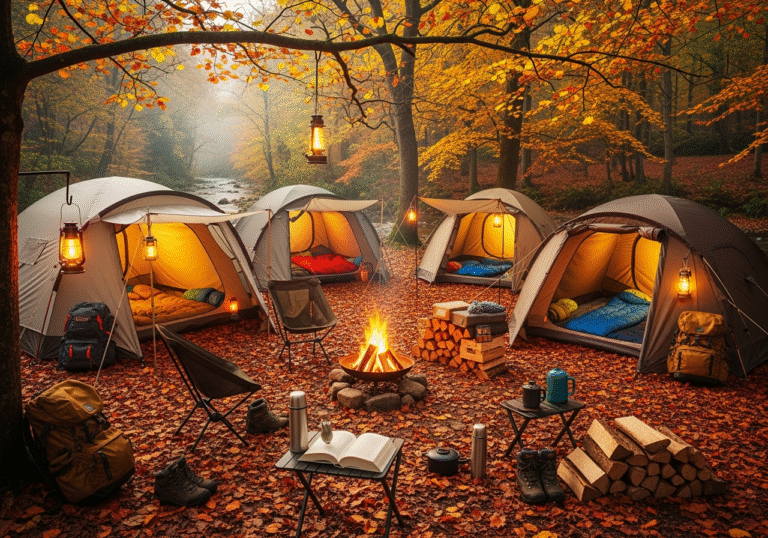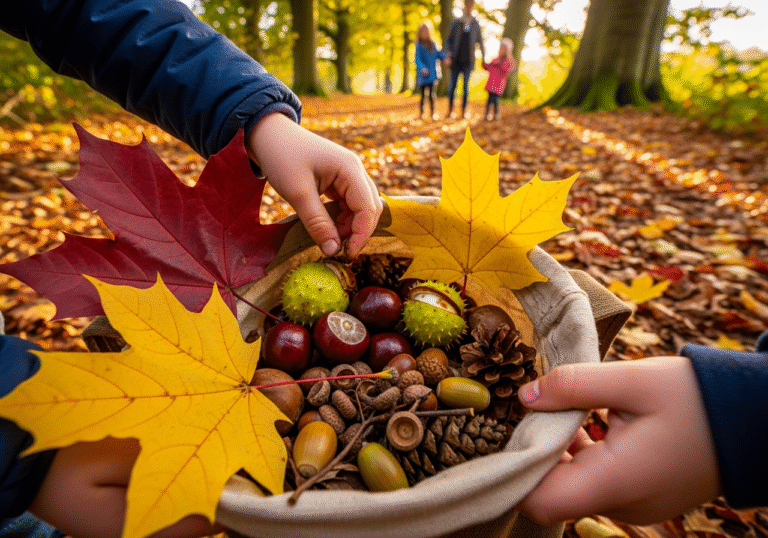The Best Guide to Solo Camping: Top Tips for Beginners in 2025
Planning your first solo camping trip? This guide covers everything from safety tips to mental preparation, helping you build confidence for a great experience.

Last Updated on 24 May 2025
Camping adventures with family and friends can create lasting memories as you strengthen bonds surrounded by natural beauty. But have you ever considered the unique rewards of venturing into the wilderness alone?
Solo camping delivers a different kind of satisfaction – complete freedom to follow your schedule while enjoying nature’s tranquillity without distraction. When I first decided to try solo camping, I only got a far as my back garden! I figured I didn’t want to jump straight in in case I didn’t like it. Since then, I’ve gone further afield and can honestly say it’s an amazing feeling knowing you’re only relying on yourself.
According to the latest Camping Trends Report from The Dyrt, solo camping’s popularity surged in 2024, with 30.6% indicating they solo camped. This is compared to 18.8% in 2021, 24% in 2022, and 29.8% in 2023.
This comprehensive guide will provide everything you need to know for planning, preparing, and enjoying your first solo camping experience in 2025.

Read more: Best AI Camping Gear for 2025: The Complete Guide
Read more: 7 Best AI Camping Gadgets: The Ultimate Buyer’s Guide in 2025
Why You Should Try Camping Alone: 5 Evidence-Based Benefits
While sharing outdoor experiences with companions has its merits, solo camping offers distinct advantages for your wellbeing and personal growth.
1. Complete Freedom and Autonomy
When camping with groups, compromises are inevitable as everyone has different expectations and energy levels. Activities and schedules often become a negotiation.
Solo camping eliminates these constraints entirely. You can:
- Wake at dawn or sleep until midday
- Hike challenging trails or relax by your campfire all day
- Change plans spontaneously without consultation
- Fully immerse yourself in activities that bring you joy
2. Enhanced Nature Connection and Mindfulness
Group camping often diverts attention to social dynamics rather than the natural surroundings. Conversations, group activities, and coordinating logistics can overshadow the environment you’ve travelled to experience.
Research published in the National Library of Medicine (2021) found that solo nature experiences trigger:
- Heightened positive emotions
- Stronger feelings of connection with natural environments
- Improved physical rest and more sleep
- Being able to switch off from technology
These benefits contribute significantly to the mental health advantages of wilderness experiences.
3. Confidence and Self-Reliance Development

In group settings, it’s easy to defer to others’ expertise or avoid challenging tasks. When camping alone, you become solely responsible for:
- Navigation and route-finding
- Shelter construction and camp setup
- Fire building and maintenance
- Problem-solving unexpected challenges
4. Reduced Stress Through Simplification
Group camping introduces social complexities – ensuring everyone’s comfort, managing interpersonal dynamics, and coordinating group decisions. These elements can introduce stress that counteracts nature’s restorative benefits.
Solo camping removes these complications, allowing you to:
- Focus exclusively on basic needs
- Establish your own rhythm aligned with natural cycles
- Avoid energy-draining social navigation
- Experience deeper relaxation and recovery
5. Practical Outdoor Skills Mastery
Camping alone accelerates skill development through necessity and direct experience. Critical outdoor competencies develop rapidly when you can’t delegate responsibilities:
- Camp selection and tent positioning
- Weather assessment and adaptation
- Natural navigation techniques
- Resource management (water, food, fuel)
- Risk assessment and mitigation
These practical skills build a foundation for future outdoor adventures and emergency preparedness in various contexts.
I remember the first time I set up my tent when I went on my first solo camp. It was getting late, and I didn’t have enough time to find the best spot, clear the area, and get my tent up. That first night, I questioned a few times why I was doing this when I had a perfectly comfortable bed at home. The next morning, I got up early, left where I was, found a new spot – after a decent hike – and managed to do everything better, resulting in a comfortable sleep. That gave me the confidence to carry on, having learnt from my mistakes!
Read more: AI Camping Navigation: The Best Guide You Need in 2025
Read more: AI Camping Apps in 2025: The Best Info is All Here to Read
11 Essential Solo Camping Tips for a Safe and Rewarding Experience
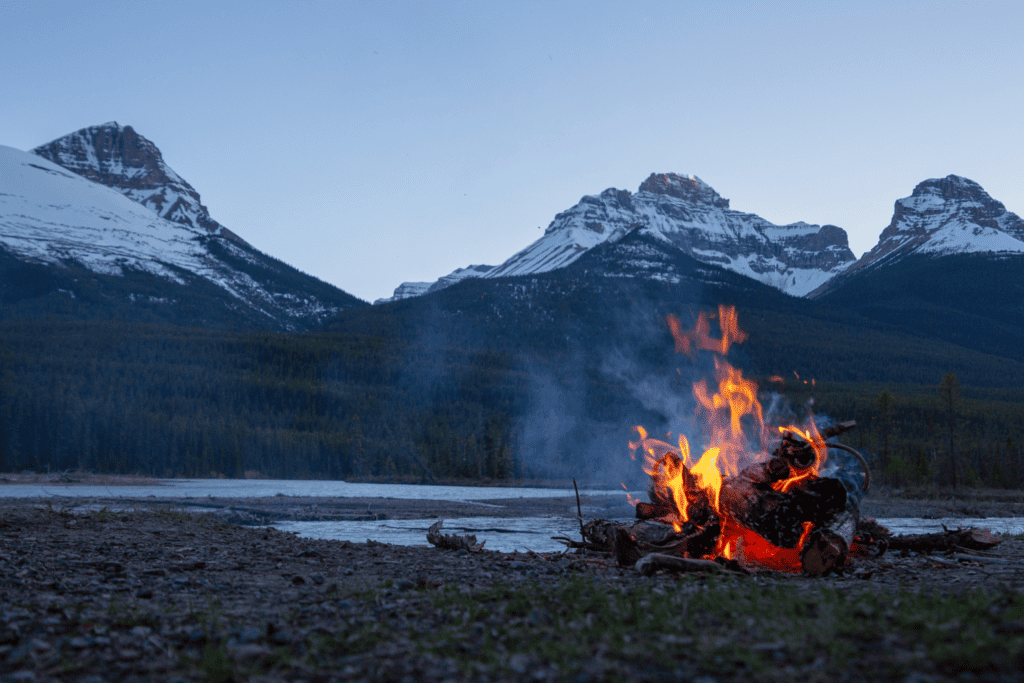
Successful solo camping requires thoughtful preparation and a measured approach. Follow these expert recommendations to ensure your first experience is both safe and enjoyable.
1. Progress Gradually with Solo Experiences
For your initial solo camping adventure, resist the temptation to seek remote wilderness locations. Beginning in isolated areas increases risk and could negatively colour your perception if challenges arise.
Recommended progression for beginners:
- Start at established campgrounds with facilities and staff
- Choose locations with mobile reception where possible
- Select areas you’ve previously visited with others
- Arrive with ample daylight for unhurried setup
- Practice navigation in the vicinity before nightfall
This gradual approach provides security while allowing you to develop confidence. Most established campsites offer fire pits, toilet facilities, and nearby assistance if needed – perfect for practising essential skills like fire-building with a safety net.
2. Thoroughly Inspect Your Gear Before Departure
Equipment failure becomes significantly more problematic when camping alone. Conduct a comprehensive check of all gear at least 48 hours before departure.
Essential pre-trip equipment checks:
- Erect your tent completely, examining for tears, broken poles or zipper issues
- Check sleeping bag zippers and inspect for thin spots or compressed insulation
- Test all batteries in torches, headlamps, and other electronic devices
- Verify stove function with appropriate fuel
- Ensure water filtration systems work properly
Consider conducting a “rehearsal night” in your garden to identify potential equipment issues while solutions remain accessible.
3. Pack Strategically with Weight Distribution in Mind

Without companions to share the load, efficient packing becomes crucial for solo campers. The British Mountaineering Council recommends keeping pack weight under 20% of your body weight for comfort and safety.
Before finalising your pack:
- Arrange all intended items and eliminate non-essentials
- Weigh your fully loaded pack
- Practice wearing it for at least 30 minutes
- Remove items until comfortable weight is achieved
- Prioritise multipurpose gear over single-use items
Remember that carrying excessive weight not only reduces your enjoyment, but also increases the risk of injury and fatigue, potentially compromising decision-making.
4. Select Appropriate Shelter for Solo Use
One-person tents often prove insufficient for comfortable solo camping. When selecting shelter, consider:
- Space efficiency: Choose a two-person tent that accommodates both you and your gear
- Setup complexity: Select designs manageable by one person in adverse conditions
- Weight-to-space ratio: Balance carrying capacity with livability
- Weather appropriateness: Ensure protection suited to expected conditions
- Visibility: Consider brighter colours for emergency situations
Modern ultralight two-person tents typically weigh only 300-500g more than one-person models while providing significantly improved comfort and functionality.
5. Bring Appropriate Entertainment
Solo evenings can feel surprisingly long without conversation to fill silence. Pack compact entertainment options suited to your interests:
- Physical books or e-readers with extended battery life
- Journal and writing implements
- Compact card games or solo puzzles
- Audiobooks or downloaded podcasts (if electronic charging available)
- Small musical instruments like harmonicas or ukuleles
These options provide mental stimulation and help establish evening routines that contribute to psychological comfort.
6. Create a Detailed Trip Plan and Share It
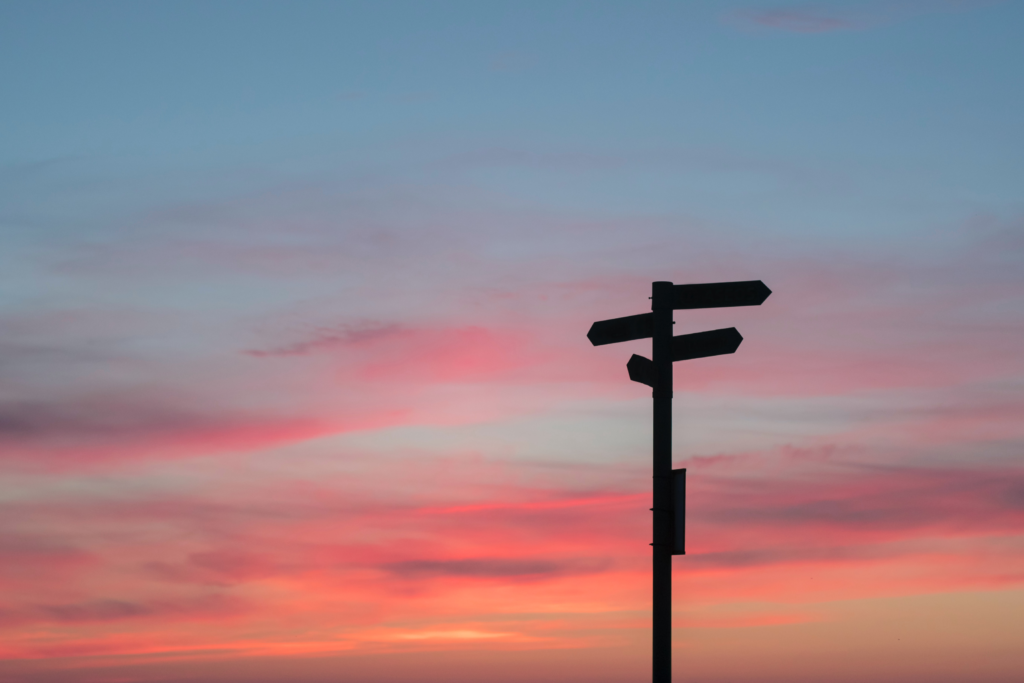
Safety for solo campers begins with comprehensive communication before departure. Create and share a detailed trip plan including:
- Specific camping location coordinates or detailed description
- Planned hiking routes with alternatives
- Vehicle details including parking location
- Complete equipment list
- Medical information and emergency contacts
- Expected check-in schedule and return time
- Local ranger station or emergency service contacts
Share this information with at least two reliable contacts and establish clear protocols for emergency response if you don’t check in as scheduled.
7. Establish Technology Boundaries
While communication technology provides important safety benefits, constant connectivity can undermine the psychological advantages of solo camping.
Consider implementing:
- Scheduled check-in times with designated contacts
- Emergency device use protocols
- Dedicated “technology-free” periods
- Battery conservation strategies
- Alternative navigation methods (map/compass skills)
Many experienced solo campers keep devices powered off except during predetermined check-in windows, preserving battery life while maintaining safety protocols.
8. Prioritise Safety Through Preparation
Solo camping safety depends primarily on thorough preparation and risk mitigation. Essential safety measures include:
- Route research: Study detailed topographical maps before departure
- Weather monitoring: Check forecasts immediately before leaving
- Communication redundancy: Carry multiple notification methods
- Navigation tools: Bring both electronic and traditional navigation tools
- Emergency shelter: Pack emergency bivvy regardless of planned accommodations
While the UK has minimal wildlife threats compared to other regions, awareness of potential hazards like cliff edges, water crossings, and sudden weather changes remains important.
9. Develop Mindfulness Practices for Anxiety Management

Even experienced solo campers sometimes experience heightened anxiety, particularly at night. During my first night, it took me ages before I went to sleep – it didn’t help that the ground was uncomfortable – but I could hear everything given how quiet it was. Rather than fighting these natural responses, develop techniques to acknowledge and manage them:
- Controlled breathing exercises: Practice 4-7-8 breathing (inhale 4 counts, hold 7, exhale 8)
- Sensory grounding techniques: Identify five things you can see, four you can touch, three you can hear, two you can smell, one you can taste
- Cognitive reframing: Challenge catastrophic thinking with evidence-based assessment
- Preparation reinforcement: Review your safety preparations when feeling uncertain
- Comfort rituals: Establish predictable evening routines that promote security
Remember that occasional anxiety is a normal biological response in unfamiliar environments and typically diminishes with experience.
10. Carry a Comprehensive First Aid Kit
Self-sufficient medical preparation becomes particularly important when camping alone. Your first aid kit should include:
- Standard supplies: Plasters in various sizes, sterile dressings, bandages, safety pins, tweezers, scissors
- Medications: Pain relievers, antihistamines, anti-inflammatory drugs, personal prescriptions
- Wound care: Antiseptic wipes, antibiotic ointment, wound closure strips
- Emergency items: Space blanket, whistle, chemical light sticks
- First aid knowledge: Take a wilderness first aid course before solo adventures
Consider investing in a quality pre-assembled wilderness first aid kit and supplementing with personal medications and additional supplies based on your specific needs and destination.
11. Monitor Weather Conditions Vigilantly
Weather represents one of the most significant variables affecting solo camping safety and enjoyment. Develop comprehensive weather awareness habits:
- Check detailed forecasts immediately before departure
- Understand how local topography affects weather patterns
- Learn to recognise changing conditions through natural indicators
- Know when to abandon plans based on weather developments
- Prepare for conditions worse than forecast
The Met Office app provides location-specific weather predictions for the UK, including detailed mountain weather forecasts, particularly valuable for solo adventurers.
Read more: The 7 Best AI Camping Watches Available Now in 2025
Read more: A Complete Guide to Smart Camping Devices to Use in 2025
Essential Solo Camping Gear: Your Complete Checklist

Solo camping requires careful equipment selection, balancing weight constraints with functionality and safety. Use this comprehensive checklist for your first adventure.
Shelter & Sleeping System
- Tent: Lightweight 2-person tent with simple solo setup (recommended models: MSR Hubba Hubba NX, Vango Nevis 200)
- Sleeping bag: 3-season bag rated at least 5°C below expected overnight lows
- Sleeping pad: Insulated pad with R-value appropriate for conditions (minimum R-value 2.0 for summer, 4.0+ for shoulder seasons, the months between the peak season and offseason)
- Pillow: Compact inflatable or stuffable pillow case
Cooking & Hydration
- Stove system: Simple integrated canister stove for beginners
- Cooking pot: Single 750ml-1L pot with lid
- Water filtration: Lightweight filter or purification method
- Water containers: Minimum 2L carrying capacity
- Mug/bowl: Insulated mug with measuring marks
- Utensil: Long-handled spork or similar multipurpose tool
- Food storage: Odour-proof bag or container
- Washing supplies: Biodegradable soap and scrubber
Navigation & Safety
- Map & compass: Physical map in waterproof case
- GPS device: Smartphone with downloaded offline maps or dedicated GPS
- First aid kit: Comprehensive kit as described above
- Emergency communication: Whistle, signal mirror, emergency contact information
- Headtorch: Primary light with spare batteries
- Backup light: Secondary compact torch
- Knife/multi-tool: Quality blade with basic tools
- Fire starting: Waterproof matches, lighter, fire starter
Clothing & Personal Items
- Base layers: Moisture-wicking, quick-drying materials
- Insulation layer: Appropriate for expected conditions
- Waterproof outer layer: Jacket and trousers
- Camp footwear: Lightweight shoes for camp use
- Hat: Sun protection and/or insulation
- Gloves: As appropriate for conditions
- Personal hygiene: Biodegradable toiletries, towel, toilet paper
- Sun protection: Sunscreen, sunglasses, lip protection
Extras & Comfort Items
- Seating: Lightweight camping chair or sit pad
- Entertainment: Book, journal, camera
- Power bank: For essential device charging
- Repair kit: Tent patches, duct tape, cord
- Insect protection: Repellent and/or head net if needed
Read more: AI Camping Navigation: The Best Guide You Need in 2025
Read more: AI Camping Apps in 2025: The Best Info is All Here to Read
Developing Essential Solo Camping Skills

Successful solo camping requires competence in several core outdoor skills. Practice these fundamentals before your first independent adventure.
Tent Setup Mastery
Most tents are designed with the assumption of multiple helpers during setup. Practice solo pitching until you can:
- Erect your tent in under 10 minutes
- Achieve proper tension on all guy lines
- Position appropriately considering terrain and weather
- Secure against wind and precipitation
- Troubleshoot common problems independently
Practice in various conditions, including wind and rain, to build true competence rather than fair-weather familiarity.
Fire Building Fundamentals
Fire provides psychological comfort, practical cooking capability, and emergency signalling when camping alone. Develop reliable fire-building skills by mastering:
- Site selection and preparation: Creating safe fire locations
- Tinder collection: Identifying and preparing easily ignitable materials
- Kindling graduation: Building progressive fuel sizes
- Fire structure: Constructing appropriate fire layouts for different purposes
- Weather adaptation: Modifying techniques for wet or windy conditions
- Fire management: Maintaining appropriate size and efficiency
- Proper extinguishing: Ensuring complete fire safety
Practice in your garden or approved areas until you can reliably create fire in various conditions before depending on this skill in remote settings.
Navigation Confidence
Solo campers must develop self-reliance in navigation, including:
- Map reading and terrain interpretation
- Compass use and bearings
- Trail marker identification
- Natural navigation techniques
- Position confirmation methods
- Route finding in unmarked terrain
- Contingency planning for navigational challenges
Consider taking a formal navigation course through organisations like the British Mountaineering Council or National Navigation Award Scheme before solo wilderness trips.
Outdoor Cooking Techniques
Efficient outdoor cooking becomes particularly important when managing all camp responsibilities alone:
- Stove operation and fuel efficiency
- One-pot meal preparation
- Water purification methods
- Food storage and protection
- Cleaning with minimal environmental impact
- Backup cooking methods
Develop a repertoire of simple, nutritious meals requiring minimal preparation and cooking time.
Read more: The Best Guide to AI Camping Weather Prediction Tools in 2025
Read more: 7 Best Affordable AI Camping Gadgets to Buy in 2025
How Do I Build and Manage a Campfire Safely When Alone?
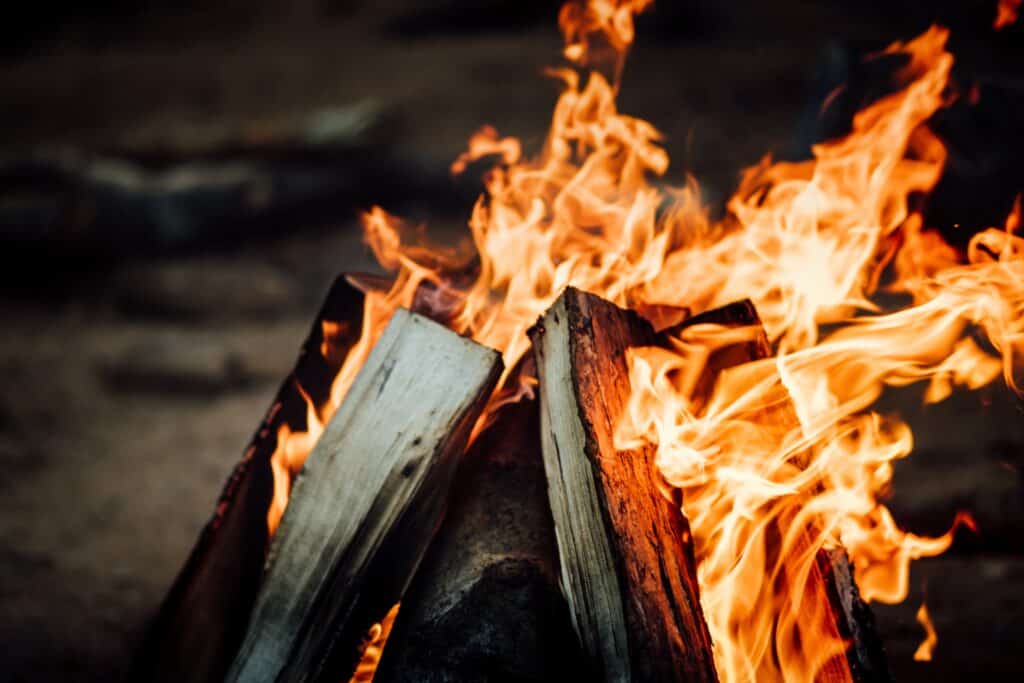
Responsible fire management follows these principles:
Fire Site Selection
- Use established fire rings when available
- Create a 3-metre clearance from flammable materials
- Check for overhead hazards
- Remove ground vegetation to mineral soil if creating a new site
- Consider prevailing wind direction
Fire Construction
- Gather materials before starting:
- Tinder: Cotton balls with petroleum jelly, birch bark, dry grass
- Kindling: Pencil-thickness sticks, increasing to finger width
- Fuel wood: Wrist-thickness pieces for sustainable burning
- Build an appropriate structure:
- Teepee style for cooking and initial establishment
- Log cabin style for sustained heat
- Lean-to configuration for windy conditions
- Proper ignition technique:
- Light at the windward side
- Start small and build gradually
- Add fuel progressively as the fire establishes itself
Fire Safety and Extinguishing
- Keep water source readily available (minimum 4 litres)
- Never leave a fire unattended for any reason
- Extinguish thoroughly:
- Drench with water completely
- Stir ashes to expose hot embers
- Continue adding water until cool to the touch
- Scatter wet ashes or remove completely, depending on local regulations
Following Leave No Trace principles, in many UK wilderness areas, consider alternatives to fires such as efficient camping stoves.
What Mental Preparation Helps First-Time Solo Campers?
Beyond physical preparation, mental readiness significantly impacts solo camping experiences:
- Set realistic expectations: Understand that some discomfort is normal and educational
- Develop comfort with silence: Practice mindfulness before your trip
- Create flexible itineraries: Allow adaptation without disappointment
- Acknowledge anxiety as normal: Prepare management techniques
- Focus on process over outcome: Value the experience regardless of “perfect” conditions
- Prepare for problem-solving: Mentally rehearse responses to common challenges
- Establish personal rituals: Create predictable routines for psychological comfort
Final Thoughts on Solo Camping
Solo camping offers unique rewards that simply cannot be replicated in group experiences. The self-reliance, natural connection, and personal discovery create a distinctive form of outdoor enjoyment increasingly sought by adventurers seeking authentic experiences.
Begin your solo camping journey with appropriate preparation, realistic expectations, and a progressive approach to building skills and confidence. Start with established campgrounds before venturing into more remote settings as your experience grows.
The satisfaction of complete self-sufficiency – from selecting your perfect camp spot to enjoying morning tea or coffee entirely on your terms – creates a sense of accomplishment that extends well beyond your camping trip. Many solo campers report these experiences as transformative, fostering confidence that transfers into everyday life challenges. I know it did for me!
Are you ready to experience the unique rewards of camping alone? With proper preparation and a positive mindset, your first solo camping adventure awaits. And don’t miss our companion guides:
- The Best Camping Checklist for 2025: Essential Gear You Need
- Stealth Camping: A Beginner’s Guide for Van or Tent Life in 2025
- The Ultimate Guide to Camping in Wales in 2025
What location are you considering for your first solo camping experience? Share in the comments below!

